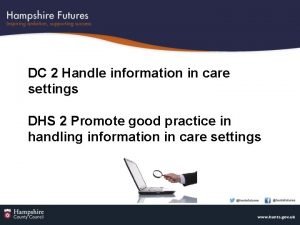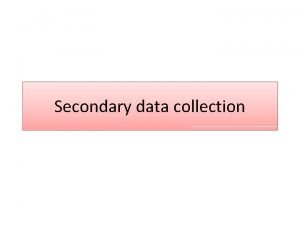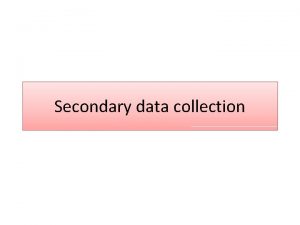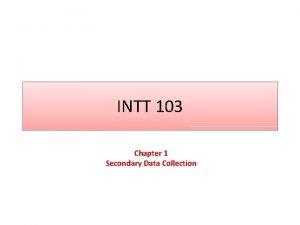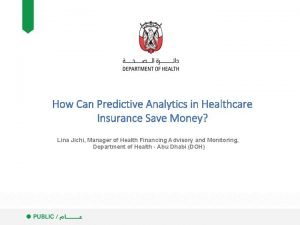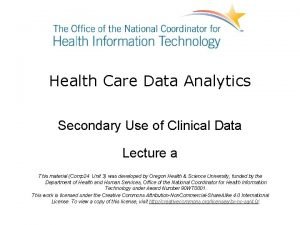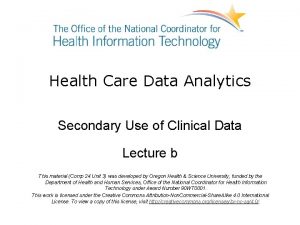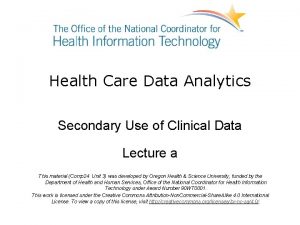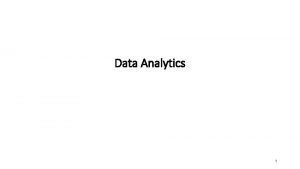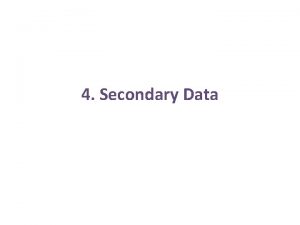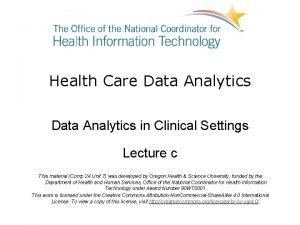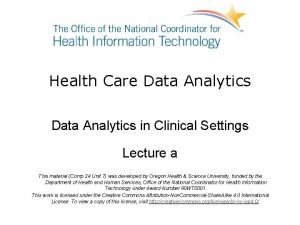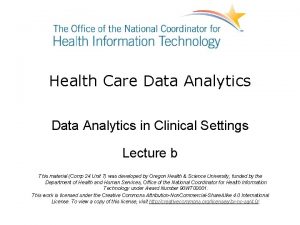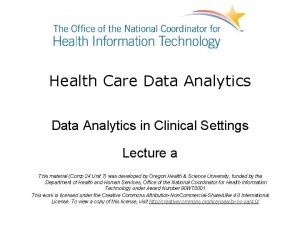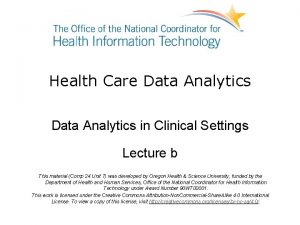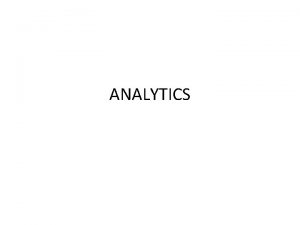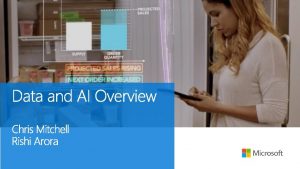Health Care Data Analytics Secondary Use of Clinical

















- Slides: 17

Health Care Data Analytics Secondary Use of Clinical Data Lecture b This material (Comp 24 Unit 3) was developed by Oregon Health & Science University, funded by the Department of Health and Human Services, Office of the National Coordinator for Health Information Technology under Award Number 90 WT 0001. This work is licensed under the Creative Commons Attribution-Non. Commercial-Share. Alike 4. 0 International License. To view a copy of this license, visit http: //creativecommons. org/licenses/by-nc-sa/4. 0/.

Secondary Use of Clinical Data Learning Objectives • Describe the secondary uses of clinical data, including EHRs (Lecture a) • Discuss the limitations and challenges of re-using clinical data (Lecture b) • Conduct a data re-use analyses for health care quality measurement utilizing a sample data set (Exercise) 2

Limitations and Challenges for Re-Using Clinical Data • Caveats for re-use of clinical data • Overcoming the caveats • Need for interoperability 3

Caveats for Re-Use of Clinical Data • Operational clinical data may be – Inaccurate – Incomplete – Of unknown provenance – Of insufficient granularity • There are many idiosyncrasies 4

Inaccurate • Documentation not always a top priority • Four known national leaders assessed use of data for studies on treatment of hypertension and found that data was: – Missing – Erroneous – Un-interpretable – Inconsistent – Inaccessible in text notes 5

Incomplete • Not every diagnosis is recorded at every visit – Absence of evidence is not always evidence of absence – censoring • Makes simple tasks challenging • Undermines ability to automate quality measures – Under-reported based on under-capture of data due to variation in clinical workflow and documentation practices – Correct when present but often missing in primary care EHRs 6

Of Unknown Provenance and Insufficient Granularity • Provenance – Where data came from – Example on slide • Granularity: – Diagnostic codes Provenance – knowing where your data come from (Seiler, 2011) assigned for billing purposes may be generalized per requirements 7

Idiosyncrasies of Clinical Data • “Left censoring” – Early part of data may be missing • “Right censoring” – Data source may not cover long enough time interval • Data might not be captured from other clinical or non-clinical settings • Bias in testing or treatment • Institutional or personal variation in practice or documentation styles • Inconsistent use of coding or standards 8

Overcoming the Caveats: Recommendations for EHR Data Use • Assessing and using data • Adaptation of “best evidence” approaches to use of operational data • Need for standards and interoperability • Appropriate use of informatics expertise 9

Focus on Interoperability • ONC for Health IT developed interoperability road map for 10 -year path forward • Emerging approaches include standard application programming interface (API) • Need for both documents and discrete data • Fast Health Interoperability Resources (FHIR) – http: //wiki. hl 7. org/index. php? title=FHIR_for_C linical_Users 10

Clinical Data Research Networks • HMO Research Network – facilitates clinical research – www. hmoresearchnetwork. org • FDA Mini-Sentinel Network – safety surveillance of medications – www. mini-sentinel. org • PCORnet – www. pcornet. org – Clinical data research networks (CDRNs) – Common data model for subset of data 11

Secondary Use of Clinical Data Summary – Lecture b • There a number of caveats for re-use of clinical data • Understanding and using best practices may allow overcoming the caveats • Efforts of overcome challenges include a focus on interoperability and leveraging clinical data research networks 12

Secondary Use of Clinical Data Summary • There are plentiful opportunities for secondary use or re-use of clinical data • We must be cognizant of caveats of using operational clinical data • We must implement best practices for using such data • We need consensus on approaches to standards and interoperability and leveraging clinical data research networks 13

Secondary Use of Clinical Data References – 1 – Lecture b References Anonymous (2014). Connecting Health and Care for the Nation: A Shared Nationwide Interoperability Roadmap Version 1. 0. Washington, DC, Department of Health and Human Services. http: //www. healthit. gov/policy-researchersimplementers/interoperability Barkhuysen, P, de. Grauw, W, et al. (2014). Is the quality of data in an electronic medical record sufficient for assessing the quality of primary care? Journal of the American Medical Informatics Association. 21: 692 -698. Bayley, KB, Belnap, T, et al. (2013). Challenges in using electronic health record data for CER: experience of four learning organizations. Medical Care. 51: S 80 -S 86. Collins, FS, Hudson, KL, et al. (2014). PCORnet: turning a dream into reality. Journal of the American Medical Informatics Association. 21: 576 -577. de. Lusignan, S and van. Weel, C (2005). The use of routinely collected computer data for research in primary care: opportunities and challenges. Family Practice. 23: 253 -263. Fleurence, RL, Curtis, LH, et al. (2014). Launching PCORnet, a national patient-centered clinical research network. Journal of the American Medical Informatics Association. 21: 578 -582. 14

Secondary Use of Clinical Data References – 2 – Lecture b References Hersh, WR, Cimino, JJ, et al. (2013). Recommendations for the use of operational electronic health record data in comparative effectiveness research. e. GEMs (Generating Evidence & Methods to improve patient outcomes). 1: 14. http: //repository. academyhealth. org/egems/vol 1/iss 1/14/ Hersh, WR, Weiner, MG, et al. (2013). Caveats for the use of operational electronic health record data in comparative effectiveness research. Medical Care. 51(Suppl 3): S 30 -S 37. Miller, DR, Safford, MM, et al. (2004). Who has diabetes? Best estimates of diabetes prevalence in the Department of Veterans Affairs based on computerized patient data. Diabetes Care. 27(Suppl 2): B 10 -21. Parsons, A, Mc. Cullough, C, et al. (2012). Validity of electronic health record-derived quality measurement for performance monitoring. Journal of the American Medical Informatics Association. 19: 604 -609. Richesson, RL, Rusincovitch, SA, et al. (2013). A comparison of phenotype definitions for diabetes mellitus. Journal of the American Medical Informatics Association. 20(e 2): e 319 -e 326. 15

Secondary Use of Clinical Data References – 3 – Lecture b References Seiler, KP, Bodycombe, NE, et al. (2011). Master data management: getting your house in order. Combinatorial Chemistry & High Throughput Screening. 14: 749 -756. Wei, WQ, Leibson, CL, et al. (2013). The absence of longitudinal data limits the accuracy of high-throughput clinical phenotyping for identifying type 2 diabetes mellitus subjects. International Journal of Medical Informatics. 82: 239 -247. Zhang, Z and Sun, J (2010). Interval censoring. Statistical Methods in Medical Research. 19: 53 -70. 16

Health Care Data Analytics Secondary Use of Clinical Data Lecture b This material was developed by Oregon Health & Science University, funded by the Department of Health and Human Services, Office of the National Coordinator for Health Information Technology under Award Number 90 WT 0001. 17
 Primary secondary tertiary medical care
Primary secondary tertiary medical care Hip fracture clinical care standard
Hip fracture clinical care standard Teramond
Teramond Care value base health and social care
Care value base health and social care Health and social care component 3
Health and social care component 3 Data protection act in health and social care settings
Data protection act in health and social care settings Syndicate sources
Syndicate sources Data collection secondary data sources
Data collection secondary data sources Secondary content analysis
Secondary content analysis Management research question hierarchy
Management research question hierarchy Primary data
Primary data Collection of secondary data
Collection of secondary data Primary data and secondary data
Primary data and secondary data Primary data and secondary data
Primary data and secondary data Primary data and secondary data
Primary data and secondary data Midas healthcare solutions
Midas healthcare solutions Truven health micromedex
Truven health micromedex Predictive analytics in health insurance
Predictive analytics in health insurance





